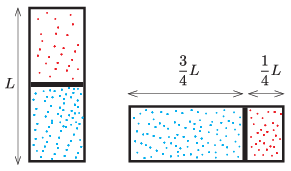 Problem P. 5422. (September 2022)
Problem P. 5422. (September 2022)
P. 5422. A closed, cylindrical tank of length \(\displaystyle L=40~\)cm, is made of heat-conducting walls and is divided into two parts with a thin piston. There is some ideal gas in both parts of the tank. Initially, the axis of the tank is vertical and the piston is in equilibrium, exactly at the middle of the tank. Then the tank is slowly turned such that its symmetry axis turns \(\displaystyle 90^\circ\), which causes the piston to move a distance of \(\displaystyle 10~\)cm. How much would the piston have moved if the tank had been rotated by \(\displaystyle 180^\circ\) instead of \(\displaystyle 90^\circ\)? The temperature is constant all the time.

(4 pont)
Deadline expired on October 17, 2022.
Sorry, the solution is available only in Hungarian. Google translation
Megoldás. Jelöljük a dugattyúra ható nehézségi erőt \(\displaystyle G\)-vel, a dugattyú keresztmetszetét \(\displaystyle A\)-val, a közös hőmérsékletet pedig \(\displaystyle T\)-vel. Legyen a kezdetben felül lévő gáz mólszáma \(\displaystyle n_1\), az alsó részben lévő gáz mólszáma \(\displaystyle n_2\). A \(\displaystyle pV=nRT\) gáztörvény szerint a dugattyú mechanikai egyensúlyának feltétele a kezdeti helyzetben:
| \(\displaystyle (1)\) | \(\displaystyle n_2\frac{RT}{\frac12LA}=n_1\frac{RT}{\frac12LA}+\frac{G}{A},\) |
a \(\displaystyle 90^\circ\)-kal elforgatott helyzetben pedig
| \(\displaystyle (2)\) | \(\displaystyle n_2\frac{RT}{\frac34LA}=n_1\frac{RT}{\frac14LA},\qquad \text{ahonnan}\qquad n_2=3n_1.\) |
Végül pedig a \(\displaystyle 180^\circ\)-kal elforgatott helyzetben (ha a dugattyú elmozdulását \(\displaystyle xL\)-lel jelöljük):
| \(\displaystyle (3)\) | \(\displaystyle n_1\frac{RT}{\left(\frac12-x\right)LA}=n_2\frac{RT}{\left(\frac12+x\right)LA}+\frac{G}{A}.\) |
(2)-t (1)-be és (3)-ba helyettesítve, majd a két egyenletet kivonva egymásból az
\(\displaystyle \frac1{\frac12-x}=\frac3{\frac12+x}+4\)
egyenletet kapjuk, amelyből a
\(\displaystyle 2x^2+2x-1=0\)
másodfokú egyenlet következik. Ennek nemnegatív gyöke:
\(\displaystyle x=\frac{\sqrt{3}-1}{2}\approx 0{,}37,\)
a dugattyú elmozdulása tehát \(\displaystyle xL=14{,}6~\rm cm.\)
Statistics:
65 students sent a solution. 4 points: Arnold Lőrinc, Beke Bálint, Bernhardt Dávid, Bogdán Benedek, Brezina Gergely, Bunford Luca, Chrobák Gergő, Csonka Illés, Fajszi Karsa, Fehérvári Donát, Flóring Balázs, Fórizs Borbála, Glaser Dávid, Hegedűs Máté Miklós, Katona Attila Zoltán, Klement Tamás, Kovács Barnabás, Kozma Bertalan, Lévai Dominik Márk, Lincoln Liu, Mészáros Ádám, Molnár Kristóf, Molnár Zétény, Nagy 456 Imre, Osváth Emese, Péntek Domonkos, Schmercz Blanka, Seprődi Barnabás Bendegúz, Seprődi Lili Borbála, Tóth Kolos Barnabás, Török Hanga, Vig Zsófia, Waldhauser Miklós. 3 points: Beke Botond, Csóka Péter, Elekes Dorottya, Görcsös Ákos Attila, Nemeskéri Dániel, Richlik Márton, Tomesz László Gergő. 2 points: 5 students. 1 point: 7 students. 0 point: 4 students. Unfair, not evaluated: 6 solutionss.
Problems in Physics of KöMaL, September 2022
